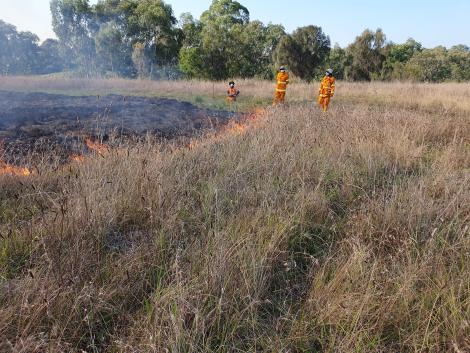As we enter warin season, MCMC begins our Autumn burns season. We share our story of the growth of our burning program originally published in our recent 2022–2024 Biennial Report. Read the full report here.
In the remnant plains grasslands of the Merri Creek valley, the delicate, star-shaped flowers of the Matted Flax-Lily add a vibrant splash of violet to the landscape. The grasslands are slowly healing, responding to an ecological burn program spanning 30 years. In 2023, this included clearing of invasive weeds and grassy biomass, creating the conditions for native wildflowers to flourish.
 Autumn burn at Bababi djinanang, Fawkner. Photograph by MCMC's Michael Longmore.
Autumn burn at Bababi djinanang, Fawkner. Photograph by MCMC's Michael Longmore.
For more than 30 years, MCMC has been at the forefront of ecological restoration, pioneering prescribed burning programs in Merri-bek City Council’s grasslands. This long-term commitment has not only transformed the landscapes but also fostered community support and understanding of fire's critical role in maintaining biodiversity.
A cornerstone of this effort is bababi djinanang grassland, in Fawkner. This four-hectare site represents one of MCMC’s most enduring success stories. Annually burned for three decades, bababi djinanang demonstrates how consistent, scientifically guided management can restore and protect native ecosystems.
The grassland supports more than 60 indigenous plant species, including the largest known population of the Matted Flax-lily. The area also provides critical habitat for reptiles such as the endangered Tussock Skink, and birds like the Black-Shouldered Kite whose presence reflects the grassland’s ecological health.
Building on this success, MCMC has broadened its prescribed burning to new sites across Merri-bek, and since 2022 has reintroduced regular fire to five grassland sites in Fawkner which had either not been burned at all in living memory or had only been burned very infrequently.
MCMC has also been trialling burns at different times of year – a shift that reflects the organisation’s commitment to adaptive management and continuous improvement.
“We normally burn in autumn or early winter,” says Sophie Lavence, from MCMC. “But in 2024 we tried a spring burn. That’s because there are a lot of summer-growing grassy weeds, soit would give us the opportunity to do some detailed weed control over the warmer months while they’re still actively growing.”
One of the most remarkable outcomes of MCMC’s work is the strong community support it has cultivated. In urban settings, prescribed burns often face public opposition. However, in Merri-bek, decades of regular burning have fostered community trust.
“MCMC have a long history of leading burns – they’re a very skilled, capable crew that we can trust to deliver good outcomes,” says Vince Andreana, Natural Resource Management Officer with Merri-bek City Council.
“The combination of that strong track record, along with the communication work we do in the community, means we very rarely have concerns from residents.”
The longstanding collaboration between MCMC, Merri-bek City Council, and local residents illustrates how conservation initiatives can thrive when they are deeply rooted in community, transparency and shared responsibility.
By maintaining and expanding its prescribed burning program, MCMC continues to create healthier, more resilient ecosystems, setting an inspiring precedent for urban conservation efforts across Australia.





 Merri Creek Management Committee. 2 Lee St, East Brunswick, Victoria, Australia 3057
Merri Creek Management Committee. 2 Lee St, East Brunswick, Victoria, Australia 3057